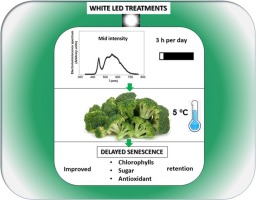当前位置:
X-MOL 学术
›
Postharvest Biol. Technol.
›
论文详情
Our official English website, www.x-mol.net, welcomes your
feedback! (Note: you will need to create a separate account there.)
Role of white light intensity and photoperiod during retail in broccoli shelf-life
Postharvest Biology and Technology ( IF 6.4 ) Pub Date : 2020-05-01 , DOI: 10.1016/j.postharvbio.2020.111121 Federico M. Pintos , Joaquín H. Hasperué , Ariel R. Vicente , Luis M. Rodoni
Postharvest Biology and Technology ( IF 6.4 ) Pub Date : 2020-05-01 , DOI: 10.1016/j.postharvbio.2020.111121 Federico M. Pintos , Joaquín H. Hasperué , Ariel R. Vicente , Luis M. Rodoni

|
Abstract White light illumination during retail has been suggested as a simple, non-chemical way to extend the shelf-life of green vegetables. Unfortunately, the influence that key factors like radiation intensity and photoperiod have on the efficacy of such treatments efficacy is barely understood. Herein, we evaluated the influence that the intensity and photoperiod of white light illumination during retail, had on the shelf-life of cold stored broccoli. Broccoli florets were stored at 5 °C and illuminated with white light emitting diodes (LEDs) under three different light intensities (Low, 3.6; Mid, 9.5; and High, 19.0 W m−2). At each light intensity condition samples were subjected to four different light:darkness cycles (3h:21 h;6h:18 h;12h:12 h or 24h:0 h). One set of samples packed and stored at 5 °C, but kept in darkness, was used as a control. After 0, 11 or 19 d of storage we evaluated weight loss, color, chlorophylls, total sugars, sucrose, glucose and fructose contents. We also assessed the changes in ascorbic acid, carotenoids and phenolic antioxidants. Mid- and High-intensitytreatments proved highly beneficial to delay senescence. Storage under Mid- and High- intensity white LEDs for 3–12 h per day was markedly more effective to prevent yellowing than continuous illumination. Exposure to Mid-intensity light, 3 h a day also reduced dehydration, chlorophyll, sucrose, glucose and fructose losses. In addition, broccoli maintained higher levels of ascorbic acid, carotenoids and phenolics at the end of the storage period. These results show that white LED illumination during retail may be used to extend the shelf-life of refrigerated broccoli and set the stage for proper intensity and photoperiod usage.
中文翻译:

零售过程中白光强度和光周期对西兰花保质期的影响
摘要 零售过程中的白光照明被认为是延长绿色蔬菜保质期的一种简单的非化学方法。不幸的是,人们几乎不了解辐射强度和光周期等关键因素对此类治疗功效的影响。在此,我们评估了零售期间白光照明的强度和光周期对冷藏西兰花的保质期的影响。西兰花小花在 5 °C 下储存,并在三种不同的光强度(低,3.6;中,9.5;和高,19.0 W m-2)下用白光发光二极管 (LED) 照明。在每种光强度条件下,样品经受四种不同的光:暗循环(3 小时:21 小时;6 小时:18 小时;12 小时:12 小时或 24 小时:0 小时)。一组样品在 5°C 下包装和储存,但保持在黑暗中,用作对照。在储存 0、11 或 19 天后,我们评估了重量损失、颜色、叶绿素、总糖、蔗糖、葡萄糖和果糖含量。我们还评估了抗坏血酸、类胡萝卜素和酚类抗氧化剂的变化。中高强度治疗被证明对延缓衰老非常有益。每天在中高强度白光 LED 下储存 3-12 小时比连续照明更能有效防止黄变。每天暴露在中等强度的光下 3 公顷也减少了脱水、叶绿素、蔗糖、葡萄糖和果糖的损失。此外,西兰花在储存期结束时仍保持较高水平的抗坏血酸、类胡萝卜素和酚类物质。
更新日期:2020-05-01
中文翻译:

零售过程中白光强度和光周期对西兰花保质期的影响
摘要 零售过程中的白光照明被认为是延长绿色蔬菜保质期的一种简单的非化学方法。不幸的是,人们几乎不了解辐射强度和光周期等关键因素对此类治疗功效的影响。在此,我们评估了零售期间白光照明的强度和光周期对冷藏西兰花的保质期的影响。西兰花小花在 5 °C 下储存,并在三种不同的光强度(低,3.6;中,9.5;和高,19.0 W m-2)下用白光发光二极管 (LED) 照明。在每种光强度条件下,样品经受四种不同的光:暗循环(3 小时:21 小时;6 小时:18 小时;12 小时:12 小时或 24 小时:0 小时)。一组样品在 5°C 下包装和储存,但保持在黑暗中,用作对照。在储存 0、11 或 19 天后,我们评估了重量损失、颜色、叶绿素、总糖、蔗糖、葡萄糖和果糖含量。我们还评估了抗坏血酸、类胡萝卜素和酚类抗氧化剂的变化。中高强度治疗被证明对延缓衰老非常有益。每天在中高强度白光 LED 下储存 3-12 小时比连续照明更能有效防止黄变。每天暴露在中等强度的光下 3 公顷也减少了脱水、叶绿素、蔗糖、葡萄糖和果糖的损失。此外,西兰花在储存期结束时仍保持较高水平的抗坏血酸、类胡萝卜素和酚类物质。











































 京公网安备 11010802027423号
京公网安备 11010802027423号